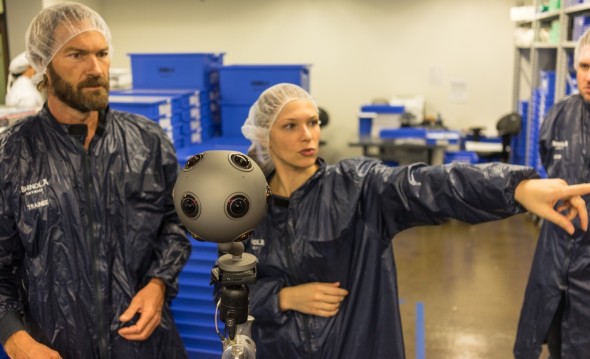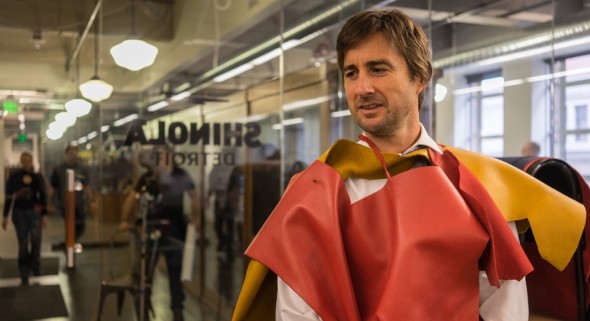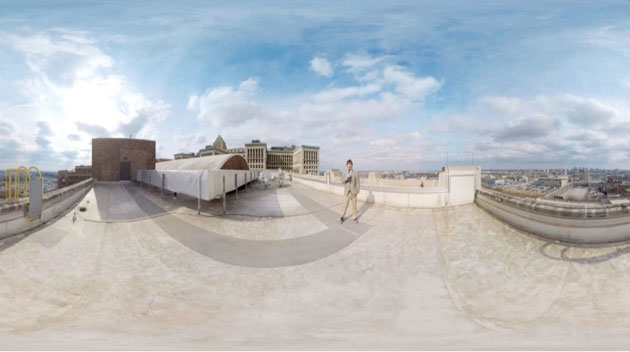Executive Producer Taylor Williams on the New Nokia Ozo, Performance Without Borders, and a Film-Like Post Workflow
How do you make a branding video — basically a tour of the Shinola factory and headquarters in Detroit, from the rooftop to the bicycle assembly floor to the clean room where watch parts are assembled — something genuinely special? Well, it doesn't hurt to wrangle brothers Andrew Wilson and Luke Wilson as directors, with Luke serving as master of ceremonies. And it also brings something new to the table to shoot it in 360. Luke's bull-in-a-china-shop approach to the facility takes on an added dimension in the wraparound environments, and 360° video makes viewers almost feel like they're in the room. We got Reel FX Executive Producer Taylor Williams to tell us more about how the Dallas-based digital studio executed the uncommonly immersive short.
StudioDaily: The 360° Nokia Ozo is a fairly new camera. Was this the first time you had used it?
Taylor Williams: Yes, this was the first time we used it. It was one of the first shoots that used the Ozo outside those Nokia was directly involved with.
Why did you select it?
The biggest thing the Ozo does for you is it gives you a live preview of what you are shooting. We were able to go around the corner and put on an Oculus and see what the camera was seeing. That's something that we all take for granted in a traditional 2D production, but it's lacking in 360 right now. It was really critical for Andrew to be able to watch the performance and play it back in 360 and see that he was getting the performance in the can. A lot of the time [with 360° and VR production] you set it up and you shoot and you're hoping you got it — but you don't know until you see the dailies.
Does the Ozo stitch the image together in real time?
It's not actually a real-time stitch, but they've got a clever system that switches camera views so the effect you get is of a full 360° stitch. If we're being technically accurate, it's not a real-time stitch, but it is a real-time preview.

Co-Director Andrew Wilson and DP Celine Tricart working with the Nokia Ozo camera
Given the newness of 360° shooting, and the technical challenges that go along with it, it must still be a science project on set. How do you get past that, and minimize that, so that the creative people have the space they need to be creative during production?
The cool thing about working with Andrew and Luke was that, while they had never worked in VR or 360 before, they were very trusting of us and the process. And a big part of our job is to make the 360 aspect as seamless as possible so they can go out and do their thing. Up front, we sent Andrew a headset preloaded with things we had worked on and things other people had done so he could do his homework and start thinking in 360° space. And then we did a scout with Luke on location and had him talk to several people on the floor at Shinola so he could meet people and see what the viewers were going to see at the end of the day. ONce we were on site and in production, we'd get set up and anticipate what they would need next so they would be ready to work in 360. They would do a take, go back and look at it, share it and get feedback from everybody from the DP on through the crew, and then take feedback from the Shinola employees who were there engaging with them on the shoot. So they would try something, see it, figure out what's working and what's not, refine it, shoot it and see it again, and keep working until it was right so we could move on to the next set-up.
It's obviously a different environment for the director, but it's got to be departure for the performer, too — especially someone who's used to delivering a performance inside a set frame. In 360 degrees, you don't have a frame.
It's a different type of performance. A lot of people have said that 360° production is closer to theatrical production than it is to film production in a lot of ways. You don't have the same editorial cheats on the back end. You can't just make something choppy and cutty, cutting between different camera angles. You've got to get the performance — and to a large degree you've got to get it in one take — with the right timing. But he was the perfect guy for this project. He and Andrew were so focused on getting a good performance. A lot of times, celebrities are tough to work with, but even through post and finishing and roll-up, they were both phenomenal.
Watching the behind-the-scenes video, I noticed you were using a GoPro rig for some shots.
That's a 360Heros rig, specifically.
Why did you use that for some shots instead of the Ozo?
The GoPro was used for anything outside. That's because we were working with a very early version of the Ozo camera firmware. It wasn't advanced enough to give us the exposure control we needed, so we had to use the GoPros outdoors.
How heavy a burden does working in 360 place on the post-production process, from editing to color?
In a lot of ways, it's more akin to old-school post-production than the nice comfy digital world. It's a proxy process akin to one-light dailies on a film transfer. The first thing we do is a rough stitch on all the footage. Absolutely everything. That's the one-light dailies equivalent. And then we take that rough stitch, or you could call it a proxy stitch, into offline editorial, where we then have every bit of footage available in 360 with rough stitches. From there, we build our edit, and we're constantly putting on and taking off a headset to view the edit in 360 while we're working. Andrew was in the edit suite with Quan, our editor, and they were both using the headset. And then, once you lock a cut, you go back and do your final stitches.
So the edit lock in 360 becomes a pivotal, key point. It's just like locking a cut in the film days, before you do your final film transfer. Once you start the final stitches, take everything to 4K, and start to do comps and cleanups and nips and tucks to get the seams as clean as possible, it becomes very difficult to go back and change the edit. You throw out a lot of effort if you change a shot at that point. Now, sometimes you have to do it. But it's not like a nice Red camera workflow. A lot of time goes into each and every frame of a 360° production.

Luke Wilson
What about color? Is that person previewing shots in 360, as well?
Color here is usually done in Lustre here, so that's primarily on the unwrapped footage. She needs to be able to see the entire scene together, and because the timing is locked at that point, viewing the 360° version isn't as critical. That said, for every step of the process, when someone hits render, we're looking at it in 360 before it moves on, and color is not an exception. While she's not working on it in real time with a headset, she's reviewing it in a headset.
What about matching color if there are disparities between camera views? Is that done in final color or during the stitch?
We do that in the stitch. You go through and balance out the image from camera to camera, and you try to blend any color-balancing issues. Nokia is pretty consistent across the frames. The GoPro definitely requires more effort. And, at the end of the day, the colorist has a lot less info to work with than usual. There are people who are shooting with giant, 15-camera Red rigs and going in [with full latitude], and that's always an option. But the budget to turn around something like that can be monstrous.
Would a shoot like that require a bigger crew, too?
This one had a pretty good-sized crew. We weren't short-changing anything. But, compared to something that would pull out all the bells and whistles, it's not at the same level. The thing with the staffing is you have to be able to hide all of your crew.
Did you have to paint elements out of the image that weren't supposed to be visible?
Definitely. For example, all of the camera rigging and cabling has to be removed. Even if you have a really low-profile tripod — and a lot of people shoot with the Ozo on a C-stand — you're getting everything in the shot, so you absolutely have to go through and paint all of it out, unless you're OK with it being in the final piece.
I know Reel FX has a dedicated VR operation. Was this completed by that division?
Well, that's the cool thing about Reel FX. We've got guys who are experts in VR and dedicated to stitching, but we're using the same colorist who does color for high-end commercials and music videos, and the comp team from our animation division and our VFX division all working on the final output. So we tap into the best of the best from each department.
Conventional wisdom is that demand for immersive video is on a pretty strong uphill slope. Does that jibe with demand you're getting from clients?
Yes, especially as more platforms like Facebook 360 and YouTube 360 mature and other new platforms are emerging every day. There are new opportunities for brands, clients and content-makers to get pieces in front of viewers. As more opportunities emerge and viewership grows, more people are interested in trying to figure out how to produce content.
Credits
Client: Shinola
Production/Post Production/Behind the Scenes: Reel FX
Co-Director: Andrew Wilson and Luke Wilson
Head of Production: Jim Riche
General Manager, Commercial: David Bates
General Manager, VR & Interactive: Steve Nix
Editor: Quan Tran
Executive Producer, Live Action: Steve Johnson
Executive Producer, Virtual Reality: Taylor Williams
Producer: Marcie Teague
Production Manager: Rachel Bradley
Director of Photography: Celine Tricart
360 Technical Directors: Ryan Hartsell, Dylan Rogers
Stitching Supervisor: Lyn Caudle
Lead Stitching Artist: Matt Stocks
Stitching Artists/Comp/Cleanup: Sungman Pyun, Dan Margules, Doug Hogan, Kelsey Craig, Jessica Hogan, Ed Whetstone, Jeff Masters, Shannon Walsh, Jared Brower, Daniel Guindi
Audio Engineer: Frank Salazar & Frank Pittenger
Editorial Assistant: Steven Happel
Production Coordinator: Julia Gibson
Creative Director: Barrett Lewis
Designer: Bill Nuske
Motion Design: James Tobias
Online: Laychin Lee
Crafts: Editing Post/Finishing Shooting
Sections: Creativity
Topics: 360-degree video reel fx shinola VR
Did you enjoy this article? Sign up to receive the StudioDaily Fix eletter containing the latest stories, including news, videos, interviews, reviews and more.










